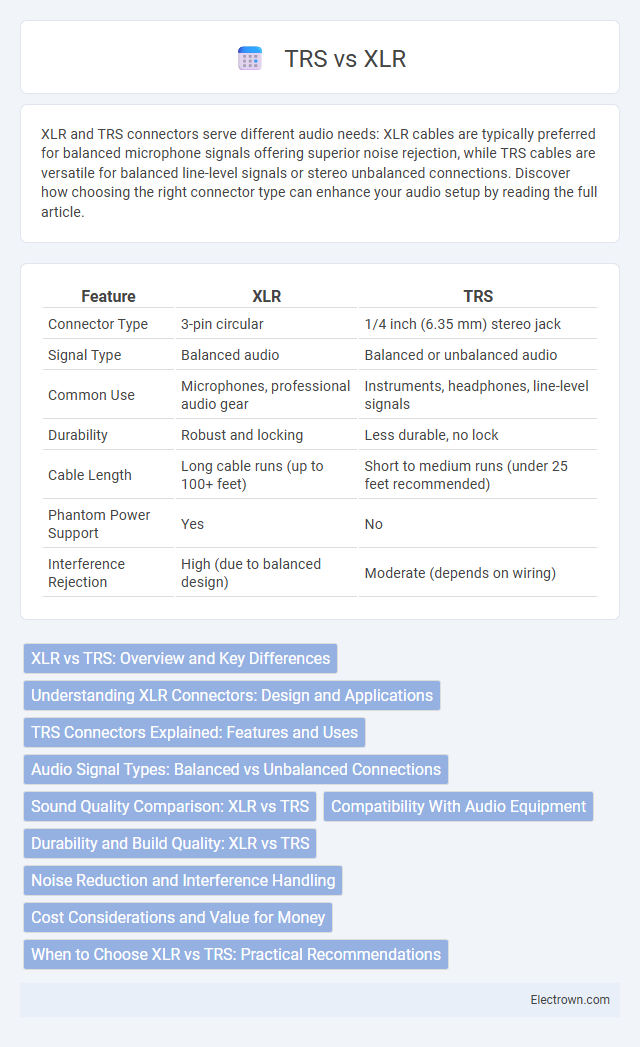XLR and TRS connectors serve different audio needs: XLR cables are typically preferred for balanced microphone signals offering superior noise rejection, while TRS cables are versatile for balanced line-level signals or stereo unbalanced connections. Discover how choosing the right connector type can enhance your audio setup by reading the full article.
Table of Comparison
| Feature | XLR | TRS |
|---|---|---|
| Connector Type | 3-pin circular | 1/4 inch (6.35 mm) stereo jack |
| Signal Type | Balanced audio | Balanced or unbalanced audio |
| Common Use | Microphones, professional audio gear | Instruments, headphones, line-level signals |
| Durability | Robust and locking | Less durable, no lock |
| Cable Length | Long cable runs (up to 100+ feet) | Short to medium runs (under 25 feet recommended) |
| Phantom Power Support | Yes | No |
| Interference Rejection | High (due to balanced design) | Moderate (depends on wiring) |
XLR vs TRS: Overview and Key Differences
XLR connectors feature three pins designed primarily for balanced audio signals, providing superior noise rejection in professional audio environments. TRS connectors, commonly found as 1/4-inch or 3.5mm jacks, support balanced mono or unbalanced stereo signals, making them versatile for headphones and instruments. While XLR cables excel in microphone connections and long cable runs, TRS cables are favored for shorter distances and line-level audio equipment.
Understanding XLR Connectors: Design and Applications
XLR connectors feature a robust circular design with three pins, commonly used for balanced audio signals in professional audio and video equipment. Their durability and secure locking mechanism make them ideal for microphones, mixers, and stage lighting systems, ensuring consistent signal quality and reduced noise interference. Understanding these design elements helps you select the appropriate connector for reliable sound transmission in your audio setup.
TRS Connectors Explained: Features and Uses
TRS connectors feature three conductors: tip, ring, and sleeve, enabling balanced audio signals and stereo sound transmission. They are commonly used for headphones, audio interfaces, and musical instruments, offering noise reduction and improved signal quality compared to unbalanced connectors. You can rely on TRS connectors for clear audio connections in professional and consumer audio equipment.
Audio Signal Types: Balanced vs Unbalanced Connections
XLR connectors are primarily used for balanced audio signals, which reduce noise and interference over long cable runs by utilizing two signal wires and a ground. TRS connectors can support both balanced and unbalanced audio signals, with balanced TRS cables resembling the XLR's noise-canceling properties but often used for shorter distances. Unbalanced TRS cables contain a single signal and ground wire, making them more susceptible to interference, especially in environments with electrical noise.
Sound Quality Comparison: XLR vs TRS
XLR connectors typically provide superior sound quality due to their balanced signal transmission, which effectively reduces noise and interference, making them ideal for professional audio environments. TRS connectors also support balanced audio but are more commonly used for shorter cable runs and less critical applications, where minor signal degradation is less noticeable. Sound quality differences become pronounced in longer cable runs and high-interference settings, with XLR maintaining cleaner, clearer audio signals.
Compatibility With Audio Equipment
XLR connectors offer superior compatibility with professional audio equipment due to their balanced design, minimizing noise and interference over long cable runs. TRS connectors also support balanced audio but are typically used for shorter distances and in consumer or semi-professional gear. Your choice depends on the gear's input/output requirements and the need for reliable, noise-free signal transmission.
Durability and Build Quality: XLR vs TRS
XLR connectors are renowned for their robust metal construction and locking mechanism, offering superior durability ideal for professional audio environments. TRS connectors, while often sleeker and more compact, typically feature less rugged build quality, making them more prone to wear and accidental disconnection over time. Choosing XLR ensures your setup maintains reliability and longevity under demanding conditions, whereas TRS suits lighter, less intensive applications.
Noise Reduction and Interference Handling
XLR connectors provide superior noise reduction and interference handling due to their balanced design that cancels out electromagnetic and radio frequency interference, making them ideal for professional audio applications. TRS connectors also offer balanced connections but are more susceptible to noise over long cable runs compared to XLR cables. XLR cables typically feature thicker shielding and locking mechanisms that enhance connection stability and minimize signal degradation in noisy environments.
Cost Considerations and Value for Money
XLR cables generally offer higher durability and balanced audio transmission, making them a reliable investment for professional audio setups despite a slightly higher price point. TRS cables, while often more affordable, provide good value for money in less demanding environments or for shorter cable runs where high-end shielding is less critical. Evaluating cost considerations alongside use case requirements ensures optimal value from either XLR or TRS connectors in audio applications.
When to Choose XLR vs TRS: Practical Recommendations
Choose XLR connectors for balanced audio connections in professional settings like microphones and mixers, ensuring noise reduction over long cable runs. Use TRS connectors when connecting stereo headphones, balanced line-level signals, or patch cables in compact setups where space is limited. Your decision depends on the application's need for durability, grounding, and audio quality to achieve optimal performance.
xlr vs trs Infographic

 electrown.com
electrown.com